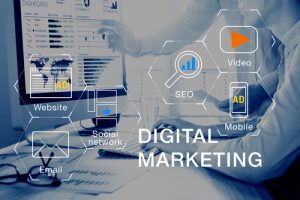Bridging Traditional Foundations with Digital Innovations in Marketing
Marketing has undergone a transformative journey over the years. From the timeless foundations of traditional methods to the revolutionary advent of digital strategies, marketers and business owners find themselves navigating a dynamic landscape. In this helpful guide, Now Media Group, a leading digital marketing agency based in San Diego, explains the intricate nuances that differentiate these two approaches—a journey essential for anyone seeking success in the contemporary realm.
Whether you’re a seasoned business owner or stepping into the field for the first time, it’s crucial to understand the two types of marketing when starting on the journey to marketing success. For personalized guidance tailored to your business needs, contact Now Media Group at (858) 333-8950.
Traditional Marketing
Traditional marketing encompasses the conventional methods that have been the mainstay of promotional activities for a significant part of business history. From the early days of print advertising to the heyday of broadcast commercials, traditional marketing channels have played a pivotal role in shaping brand narratives.
The Key Components
- Print Advertising: Newspapers, magazines, billboards—print advertising has been a cornerstone of traditional marketing, offering tangible and visually impactful ways to reach a wide audience.
- Broadcast Advertising: Television and radio commercials have been iconic mediums, allowing brands to convey their messages to mass audiences through sight and sound.
- Direct Mail: Sending physical promotional materials directly to consumers, such as catalogs or brochures, is a targeted form of marketing that predates the digital era.
- Telemarketing: Utilizing phone calls to connect with potential customers, telemarketing was a prevalent method for engaging in direct conversations to promote products or services.
Advantages
- Tangible and Physical Presence: Traditional marketing materials have a physical form, providing a tangible presence that can leave a lasting impression on consumers.
- Targeting Specific Demographics: Traditional methods allow for reaching specific demographic groups through carefully selected channels, tailoring the message to a particular audience.
- Established Consumer Trust: Over the years, traditional marketing has built a level of trust with consumers, as they are familiar with and accustomed to these time-tested approaches.
Digital Marketing
Digital marketing is the contemporary counterpart to traditional methods, leveraging online platforms and technologies to promote products or services. Its emergence coincided with the rise of the internet and digital technologies, marking a paradigm shift in how businesses connect with their audience.
The Key Components
- Social Media Marketing: Platforms like Facebook, Twitter, and Instagram offer dynamic spaces for brands to engage with their audience, share content, and build relationships.
- Content Marketing: Creating and distributing valuable, relevant content is a cornerstone of digital marketing. Blogs, videos, and infographics serve as tools to inform and captivate the online audience.
- Search Engine Optimization (SEO): Optimizing online content for search engines enhances visibility, ensuring that businesses are discoverable when potential customers search for relevant products or services.
- Email Marketing: Sending targeted messages directly to a user’s inbox is an effective way to nurture leads and maintain ongoing communication with customers.
Advantages
- Global Reach: Digital marketing transcends geographical boundaries, enabling businesses to reach a global audience and expand their market presence.
- Real-time Interaction and Engagement: Immediate feedback and interaction with the audience are possible through social media and other digital channels, fostering a sense of community and responsiveness.
- Data-Driven Decision-Making: Digital marketing provides robust analytics and data insights, allowing marketers to measure the effectiveness of campaigns, understand customer behavior, and make informed strategic decisions.
Differences Between Traditional and Digital Marketing
Communication Channels
Traditional marketing relies on one-way communication channels, where the message is broadcast to the audience without immediate interaction. Examples include TV commercials, radio ads, and print materials.
Digital marketing, in contrast, facilitates two-way communication. Social media platforms, blogs, and forums allow for real-time interaction, enabling businesses to engage in conversations with their audience, respond to feedback, and build relationships.
Cost
Traditional marketing often involves high production costs for materials like print ads or TV commercials. Distribution costs can also be significant, especially for widespread campaigns.
Digital marketing tends to be more cost-effective, particularly for small businesses. Online advertising, social media campaigns, and email marketing can be executed with relatively lower production and distribution expenses.
Measurement and Analytics
Traditional marketing methods often lack comprehensive tracking mechanisms. Measuring the success of a TV ad or billboard can be challenging, making it difficult to assess the return on investment (ROI) accurately.
Digital marketing provides robust analytics tools. Marketers can track website visits, engagement rates, conversion metrics, and more. This data-driven approach enables businesses to measure the success of campaigns and adjust strategies in real time.
Targeting and Personalization
Traditional marketing typically employs broad demographic targeting. Advertisements in newspapers or on TV may reach a wide audience, but personalization is limited compared to digital methods.
Digital marketing allows for precise audience targeting based on demographics, interests, and online behavior. Personalized content, such as targeted social media ads or email campaigns, enhances relevance and engagement.
Integration of Traditional and Digital Marketing
Recognizing the Strengths of Both Approaches
Traditional’s Brand Establishment
Traditional marketing plays a crucial role in establishing and solidifying a brand’s presence. TV ads and print materials can create a sense of credibility and familiarity that digital channels might take time to achieve.
Digital’s Dynamic Engagement
Digital marketing excels at dynamic engagement. Social media interactions, real-time feedback, and viral campaigns enable businesses to connect with their audience on a more personal level, fostering a sense of community.
Developing an Integrated Marketing Strategy
Understanding the Target Audience
Combining insights from traditional and digital channels helps create a comprehensive understanding of the target audience. This holistic view guides the development of marketing messages that resonate across various platforms.
Utilizing Cross-Channel Promotion
Integrating traditional and digital efforts allows businesses to cross-promote. For example, a TV ad can prompt viewers to visit a website, participate in a social media campaign, or subscribe to a newsletter, creating a seamless customer journey.
Examples of Successful Integrated Campaigns
Coca-Cola’s “Share a Coke” Campaign
This campaign utilized traditional methods like personalized labels on Coke bottles while leveraging digital channels to encourage consumers to share their experiences on social media. The integration resulted in widespread engagement and brand visibility.
Old Spice’s “The Man Your Man Could Smell Like” Campaign
Old Spice combined humorous TV commercials with a strong digital presence. Social media interactions, personalized video responses, and online contests amplified the impact of traditional TV ads, creating a viral sensation.
Ready to Elevate Your Marketing Strategy? Contact Now Media Group!
Whether you’re a seasoned business owner or just starting, Now Media Group is here to guide you through the dynamic world of digital marketing. Elevate your strategies, merge tradition with innovation, and achieve marketing success tailored to your business. Call now at (858) 333-8950!
Let Now Media Group be your partner in navigating the evolving landscape of marketing. Contact us today and discover personalized solutions that align with the demands of the contemporary market. Your success journey begins with a single call.
